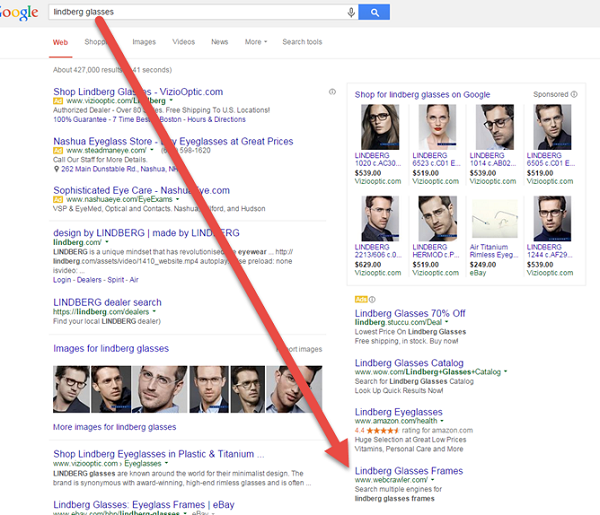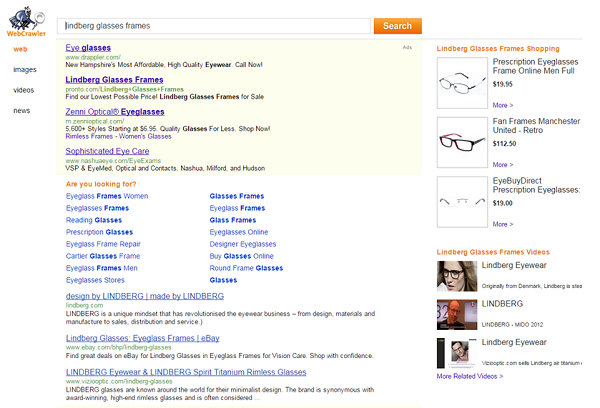Recently, AdWords once again announced what it is doing about bad advertising practices in a review of 2014. It’s actually done this every year since an original announcement in 2012.
Last year, in a review of 2013, they provided an overview of how Google AdWords worked to stop bad advertising during the year.
And here’s a breakdown of their primary efforts in 2014:
- Combating counterfeit goods.
- Protecting against malicious software.
- Fighting weight loss and dietary supplement scams.
In this post, we’ll look at some of the bad advertising trends out there, and how advertisers can play by the rules to avoid them.
Black Hat Advertisers: Real-World Examples
I talked about dirty advertising tactics not too long ago at Search Engine Land. In that article, I brought up the “black hat” PPC techniques that break the rules of engagement and hurt the honest players. Group Twenty Seven saw this in action when we discovered a competitor slandering a client’s brand.
What happened was this competitor maintained a microsite dedicated to criticizing our client’s product, and declaring their own superior. While the site itself followed all the basic AdWords guidelines for a PPC campaign, the content was a prime example of dirty, black hat tactics.
I reached out to my friend and colleague, Barbara Young, of PPC-Strategies to see if she had any examples of bad actors in the pay-per-click world. She did, and here’s what she had to share.
“We discovered an AdSense bad actor using AdWords arbitrage,” said Barbara.

“The PPC text ad lands here,” she pointed out. “It’s a crappy site with more PPC ads.”

Barbara then highlighted that a Google AdWords help file clearly calls out this type of practice, and deems low-quality content as:
Content that is designed for the primary purpose of showing ads
Examples: Driving traffic (whether through “arbitrage” or otherwise) to destinations with more ads than original content, little or no original content, or excessive advertising
It’s amazing these bad actors are still slipping through the cracks, but sadly, they are. Let’s look at some other ways advertisers practiced bad advertising in 2014, shall we?
2014 Trends in Bad Advertising
In 2014, the bad ad trends included:
- Violating AdWords policies related to copyright infringement (more than 4.3 million ads).
- Using “trick to click” approaches (more than 43 million ads).
- Attempting to sell counterfeit goods (more than 7,000 advertisers).
- Attempting to practice phishing (more than 5,000 advertisers).
- Violating healthcare-related policies (more than 9.6 million ads).

Some of these practices are malicious, and some could be a case of simply not knowing the rules. Let’s look at a couple areas where knowing the rules may help all advertisers continue to be approved by AdWords.
AdWords Policies: Copyright Infringement and Healthcare Ads
Copyright infringement and healthcare-related violations were two of the most troublesome trends in 2014. AdWords offers some guidance in the help files for how to stay within the rules on both of these.
Here’s the policy on copyright infringement:
- Unauthorized distribution of copyrighted content includes sites or software that capture, copy and provide copyrighted content. They might authorize offline distribution of said content, or circumvent the copyright with technological tools.
- Violating the policy can result in ad disapproval, domain disabling and account suspension.
From AdWords:
To ensure a safe and positive experience for users, Google requires that advertisers comply with all applicable laws and regulations in addition to the Google AdWords policies. It’s important to familiarize yourself with and keep up to date on these requirements for the places where your business operates, as well as any other places your ads are showing.
On the other hand, if your copyright is being infringed upon, follow the complaint filing process so that Google can investigate.
Here’s the policy on healthcare-related advertising:
- Google restricts the promotion of healthcare-related content about things like over-the-counter medications, pharmacies, medical devices, clinical trial recruitment, sexual enhancement treatments and others.
- The restrictions can vary by product, service and targeted country.
- Family or non-family status is assigned to each ad to designate the appropriate audience. One example of non-family status would be sexual enhancer advertisement.
- If your ads are disapproved or your site is suspended, make the proper changes and resubmit.
- Violating this policy can result in ad disapproval, domain disabling and account suspension.
From AdWords:
Some content, such as unapproved pharmaceuticals and supplements, can’t be promoted anywhere. Depending on the content that you’re promoting and the countries where your ads appear, you may need to apply for pre-authorization with Google before advertising healthcare-related content.
We’re always going to have dishonest advertisers using black hat tactics, but knowing the rules beforehand helps you stay out of trouble by accident, and identify a problem should it arise. To report bad advertising to Google, contact Google AdWords and file your complaint.
For additional reading on why your ads may be disapproved, check out this post.






